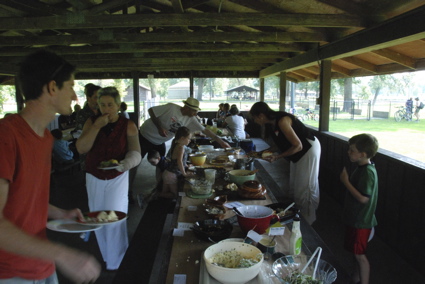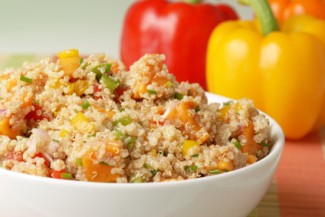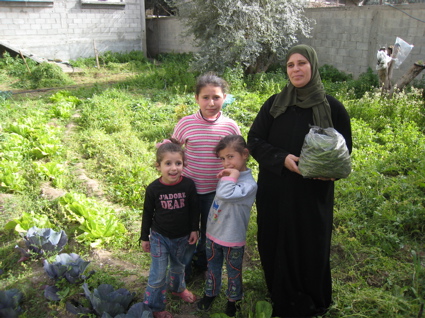 Chowing down for better school lunches in Iowa City.Photo: Kurt Michael FrieseAll across the country this past Labor Day, folks gathered for picnics. That’s no surprise, of course. After all, it was a holiday, and the weather was grand across nearly the whole continent. But there was something unique about one group of picnics; 307 of them to be exact, in all 50 states. They were dubbed “Eat-Ins” (modeled on the sit-ins of the ’60s), and they were a call to action by Slow Food USA
Chowing down for better school lunches in Iowa City.Photo: Kurt Michael FrieseAll across the country this past Labor Day, folks gathered for picnics. That’s no surprise, of course. After all, it was a holiday, and the weather was grand across nearly the whole continent. But there was something unique about one group of picnics; 307 of them to be exact, in all 50 states. They were dubbed “Eat-Ins” (modeled on the sit-ins of the ’60s), and they were a call to action by Slow Food USA
At those picnics, including one right here in Iowa City, more than 20,000 people gathered around tables in parks and farms and school grounds to tell Congress to fix the School Lunch Program. Most of the discussions at these events and in the press afterwards centered on improving the food itself through increased Federal spending and local food initiatives. But there was another topic directly relevant to Labor Day: the call to create green jobs with a “School Lunch Corps.”
As the platform promoted by Slow Food states:
We can’t serve real food in schools without investing in school kitchens and the people who prepare and serve lunch. This spring, President Obama signed the Serve America Act, which expanded Americorps and reinforced his call for Americans to serve their country. Right now, our nation has an opportunity to train young and unemployed Americans to be the teachers, farmers, cooks and administrators we need to ensure the National School Lunch Program is protecting children’s health. President Obama has called for an end to childhood hunger by 2015; let’s answer that call by putting Americans to work building and working in school kitchens nationwide.
It bears emphasizing that the School Lunch Corps idea is not an attempt to vilify today’s lunch ladies–or squeeze them out of a job. No one at Slow Food is devaluing the hard work of the thousands of people who work in school kitchens, commissaries, and cafeterias. These folks are dedicated laborers, many of them Union members, whose hands are tied by sometimes outlandishly picayune regulations.
For example, to be permitted to serve a simple but healthy dish of red beans and rice in a school cafeteria–according to Iowa City Schools food service director Diane Duncan-Goldsmith–kitchen workers must add meat or cheese. Doesn’t matter that the dish is already a complete protein. Regulations, serving no one but dairy and beef interests, insist that main dishes must contain meat or cheese. This raises the cost and the calorie count, but adds little to the nutritional value of the meal.
Most of the food served in school cafeterias comes packaged in paper or plastic or cans, and is shipped in from an average of 1500 miles. Multiply that by the 30 million meals served in schools everyday and the impact on greenhouse gasses and the waste stream become readily apparent.
All this doesn’t even touch on the potential health effects of the food our children are eating. The keynote address at our Eat-In was delivered by Rep. Dave Loebsack (D-IA), who sits on the House Education and Labor Committee, the panel with jurisdiction over the Child Nutrition Act reauthorization. Mr. Loebsack emphasized the connection between healthy kids and the future of our entire health care system, noting that one in three kids born after 2000 will contract diabetes before they’re old enough to vote; among minorities that number rises to one in two.
Thus a diet that puts more emphasis on whole grains and fresh vegetables, with meat as a side dish or condiment rather than the center of the plate is, as ever, the only healthy, viable alternative. As an example, the dish I brought to our Eat-In was a slight twist on classic tabouleh, with everything but the grain coming from my restaurant’s garden (I haven’t tried to grow quinoa yet).
 Quinoa with fresh veggies–coming soon to a school cafeteria near you? Quinoa Tebouleh
Quinoa with fresh veggies–coming soon to a school cafeteria near you? Quinoa Tebouleh
2 cups quinoa, cooked
1 cup green lentils, cooked
1 medium red onion, diced
2 medium ripe tomatoes (1 red, 1 yellow if possible for color), diced
1 cucumber (“English” or hothouse variety preferred), diced
1 sweet bell pepper, seeded and diced
3 cloves garlic, peeled and sliced paper thin
1/2 cup chopped cilantro and/or spearmint
Optional additions: 1/2 cup olive oil; 3 tablespoons fresh lemon juice
Simply toss all ingredients together, season to taste with salt and pepper, and refrigerate one hour to overnight. Serves 6-8
Note: Quinoa (pronounced KEEN-wah) is a South American grain. It’s extremely nutritious and cooks up just like rice. Also, the lentils should be tender but not mushy.




